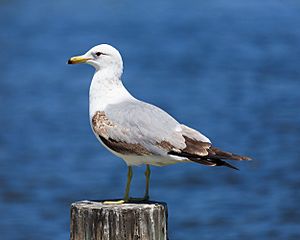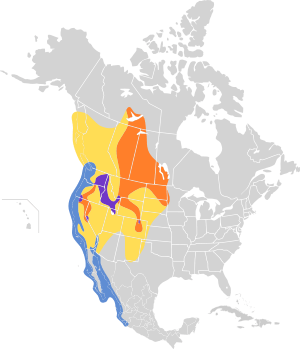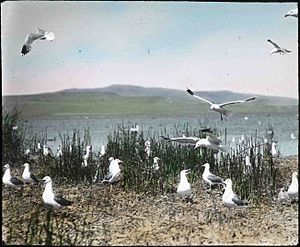California gull facts for kids
Quick facts for kids California gull |
|
|---|---|
 |
|
| California gull in Palo Alto, California | |
| Conservation status | |
| Scientific classification | |
| Genus: |
Larus
|
| Species: |
californicus
|
| Subspecies | |
|
|
 |
|
The California gull (Larus californicus) is a type of gull. Many people also call it a seagull. It's a medium-sized bird. It's usually smaller than a herring gull but bigger than a ring-billed gull.
Contents
What Do California Gulls Look Like?
Adult California gulls look a lot like herring gulls. But they have some key differences. They have a smaller yellow beak with a black ring around it. Their legs are yellow, and their eyes are brown. Their heads are also more rounded.
Their bodies are mostly white. Their backs and upper wings are grey. The tips of their main wing feathers are black with white ends. Young gulls look similar to young herring gulls. They have browner feathers than young ring-billed gulls.
California gulls are about 46 to 55 centimeters (18 to 22 inches) long. Their wings can spread out from 122 to 137 centimeters (48 to 54 inches). They weigh between 430 and 1045 grams (about 1 to 2.3 pounds).
Where Do California Gulls Live?
California gulls breed near lakes and marshes. You can find them in the western part of North America. This includes places from the Northwest Territories in Canada down to eastern California and Colorado.
They build their nests in groups called colonies. Sometimes, they share these colonies with other types of birds. Their nest is a shallow dip in the ground. They line it with plants and feathers. The female gull usually lays two or three eggs. Both parents take turns feeding their baby chicks.
These gulls are migratory birds. This means they travel to different places during the year. Most of them fly to the Pacific coast for winter. This is why you often see them in western California during the colder months.
How Do California Gulls Behave?
California gulls find their food in different ways. They might catch food while flying. Or they can pick things up while swimming, walking, or wading in water.
They mostly eat insects and fish. They also eat the eggs and young of other birds, like ducklings. These gulls are also "opportunistic feeders." This means they will eat whatever food they can find. They often look for food at garbage dumps, marinas, and docks.
You might see them begging for food at beaches or parks. They sometimes follow fishing boats. They also follow plows in fields. This is because the plows stir up insects from the ground.
State Bird of Utah
The California gull is the official state bird of Utah. This is because of a special event in history. Mormon settlers in Utah faced a big problem with Mormon crickets. These crickets were destroying their crops.
Many gulls came and ate the crickets. This saved the crops and the settlers. People called this event the "Miracle of the Gulls". There is a monument in Salt Lake City that remembers this important event.
Types of California Gulls
There are two main types, or subspecies, of California gulls.
- The first type is called L. c. californicus. It lives in the Great Basin area, stretching to central Montana and Wyoming.
- The second type is L. c. albertaensis. This one is a bit larger and has paler feathers. It lives further north, from Great Slave Lake to the Great Plains in western Manitoba and South Dakota.
Even though they look a bit different, these two types are very similar genetically. Scientists believe they were separated a long time ago. Then they met again more recently in Montana.
California Gulls in California
In California, the California gull used to be a protected species. This was because their numbers were going down at Mono Lake. This was a historic breeding spot for them.
However, in recent years, their population has grown a lot. They started breeding in the southern part of San Francisco Bay. They didn't used to breed there. They now live in large salt ponds and levees. They also find a lot of food from nearby places where people dispose of waste. This includes areas from San Francisco to San Jose and even up to Sacramento.
The number of California gulls in the South Bay grew from less than 1,000 in 1982 to over 33,000 in 2006. This big increase has led to large groups of gulls living there all year. These gulls sometimes eat the eggs and young of other birds. This can affect birds like the snowy plover and California least tern. Other birds like black-necked stilts and American avocets can also be affected. People are working to manage the gull population in these areas.
Even though it's called the California Gull, it's the state bird of Utah.
See also
 In Spanish: Gaviota californiana para niños
In Spanish: Gaviota californiana para niños





